TNA to IAP Node
Digital Ionospheric Sounder DPS4D:
- Vertical soundings
- Oblique soundings
- Drift measurements
- Supervised operations in bi-static link mode DPS4D experimental facilities operated by NOA, OE, IAP, RMI, INGV able to adjust the operations schedule to fit the PITHIA-NRF requirements for synchronized operations and special campaigns
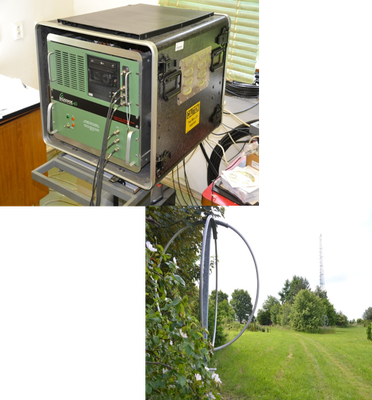
Ionospheric sounder at Průhonice station is in operation since 1957. A new digital portable sounder (DPS) operating since 2004 is also able to provide main ionospheric characteristics, electron profiles and measure angle of arrival of sounding waves and plasma drifts.
Most of Pruhonice data are manually checked.
Continuous Doppler Sounding System (CDSS):
- Doppler shift measurements
- Monitoring of AGW propagation
- Detection of infrasound signatures in the ionosphere
CDSS is operating by IAP in Central Europe, South Africa, Argentina and Taiwan.
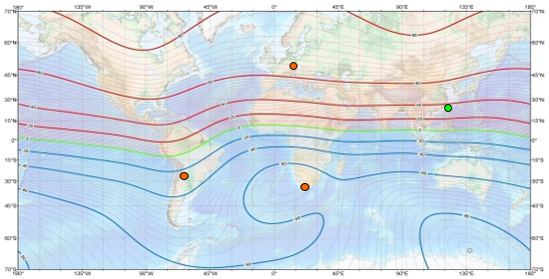
Multi-point continuous Doppler sounding makes it possible to investigate propagation of atmospheric waves(direction, velocity, periods, for special cases – amplitudes) and disturbances of the upper atmosphere and ionosphere such as spread F, ionospheric response to solar flares, to geomagnetic and seismic activity, disturbances related to severe tropospheric convection, solar eclipse, solar terminator, man-made explosions.
The advantage of CDSS is continuous sounding and a high time resolution (around 10 s).
Infrasound undergoes only little attenuation and can propagate over large distances providing information not only about distant processes but also about the atmosphere, including stratosphere, through which it propagates as the local temperature and winds influence the propagation.
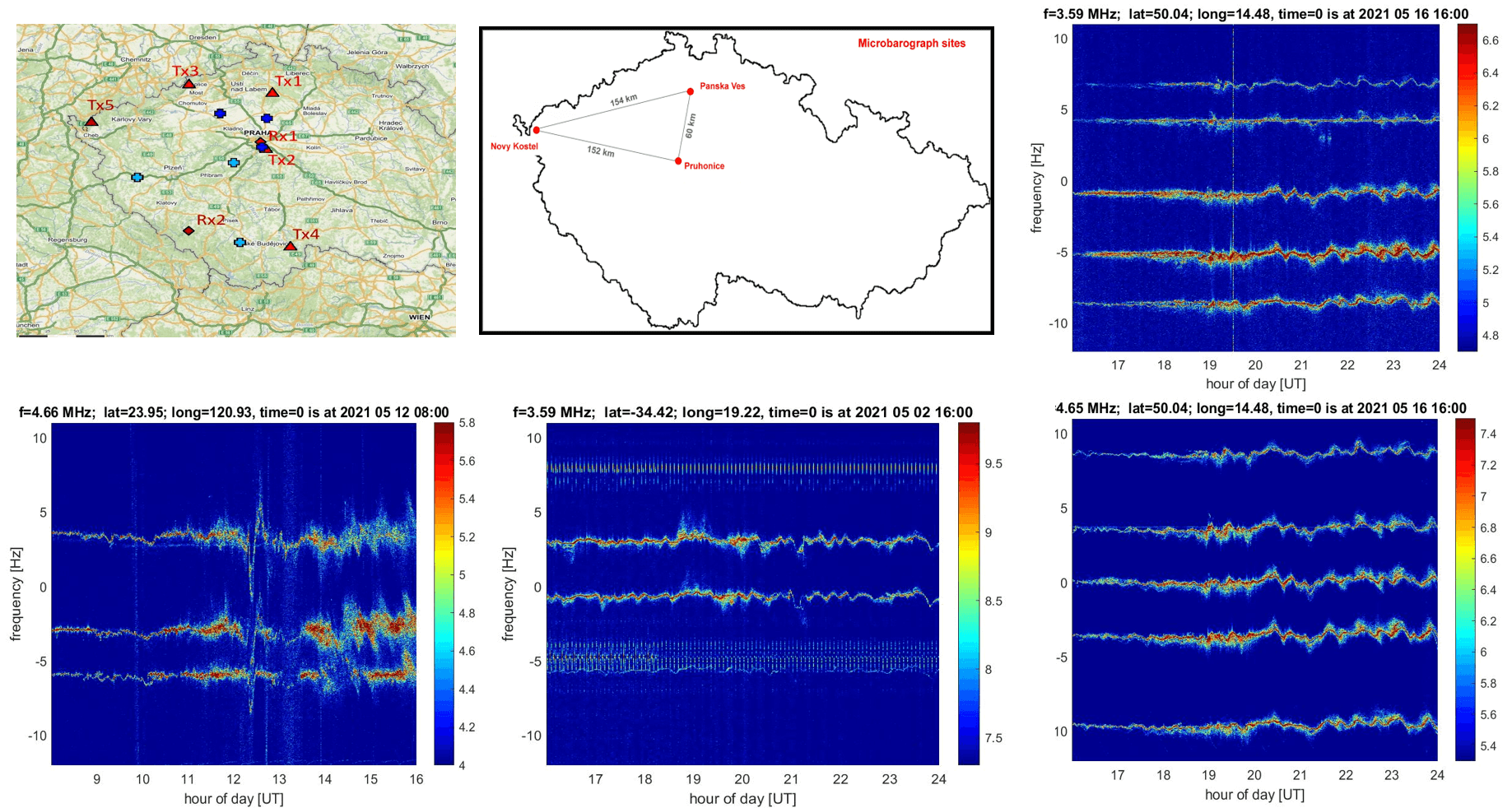
An example of observations of oblique spread structuresin Doppler shift spectrogram recorded at Tucumanfrom 01:00 UT to 07:00 UT on 25 October 2013. Such a spread has never been observed by the Czech Doppler network at midlatitudes.
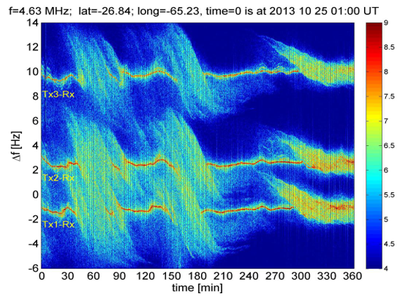
Doppler shift (Czech network) response to geomagnetic micropulsations. Continuous Wavelet Transforms (CWT) of magnetic field and ionospheric oscillations measured by Doppler shift. The analysis starts on 4 May 2007 at 19:55 UT. From top to bottom: WT of magnetic field amplitude, north–south component, east–west component and Doppler shift record.
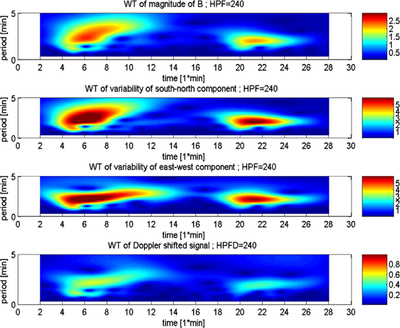
Effects of severe tropospheric weather. Fourier spectrum show much higher wave activity on 29 July 2005, day of strong stormy convection, than on quiet days. Thick line: amplitude spectrum on 29 July 2005. Thin line: median of Fourier spectra on quiet days. Dashed lines: lower quartile and upper quartile of Fourier spectra on quiet days.
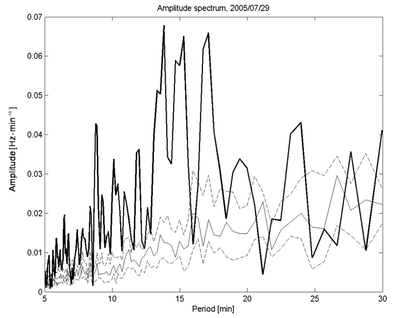
Electric Field Mill:
- Atmospheric electricity (electrostatic field) in Czech and Slovak Republic using Electric Field Mills (EFM)
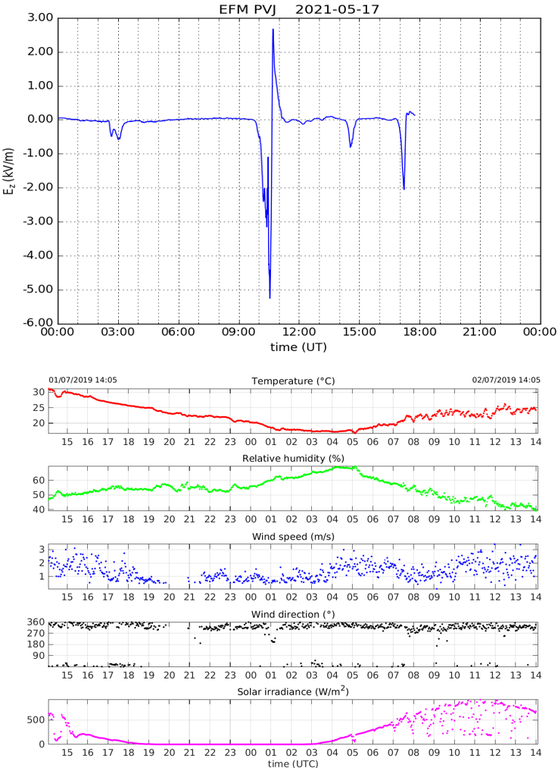
The electrostatic field is a consequence of a potential difference (around 250 kV) between the electrically conducting ionosphere and the Earth. The potential difference results from charge separation in clouds, usually in the thunderclouds. Interplanetary magnetic field in the solar wind might also contribute to the potential difference at high latitudes. A typical value of electric field intensity in a free flat terrain at the ground during fair weather is about 100 V/m. Local weather – charged thunderclouds cause distinct changes of the local electric field. Consequently, the local electric field can reach values of several kV/m, and even about 100 kV/m at distinct sharp high-mountain peaks.
Pruhonice DPS 4D:
15-min time resolution for vertical sounding and angle of arrival of sounding waves and for plasma drifts;
5 min resolution for oblique sounding
The data are sent to several world databases and archived in the DIDBase mirror site located at IAP.
Access is available using SAO Explorer via GIRO and IAP mirror DIDBases or via IAP website http://147.231.47.3/.
CDSSs networks:
CDSS is sounding continuously with high time resolution (around 10 s).
The raw data (in ASCI and graphic formats), data products and specific SWs for data analysis are stored in the IAP savers and are accessible under request.
Electrostatic field measurements:
The data and specific SW for data analysis and calculations are stored in the IAP savers and available under request.
Tropospheric and ionospheric real time measurements (public access)
https://www.ufa.cas.cz/en/for-the-public/results-of-real-time-measurements/
Areas of access
- Analysis of wave coupling processes and consequences in the whole atmosphere and ionosphere using CDSSs and European Digisonde network measurements.
- Validation of medium scale TIDs detection techniques.
- Ionosphere/gravity wave climatology.
- Troposphere – upper atmosphere – solar wind coupling studies exploiting atmospheric electricity, ionosphere and solar wind data.
TNA to IAP Node info (downloadable pdf file)
Contact person: Dr Dalia Buresova (Obrazova) (buresd@ufa.cas.cz), Dr Jaroslav Chum (jachu@ufa.cas.cz)
